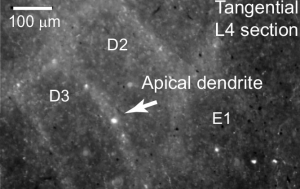Category: Publications & Preprints
-
Adolescent maturation of inhibitory inputs onto cingulate cortex neurons is cell-type specific and TrkB dependent
The maturation of inhibitory circuits during adolescence may be tied to the onset of mental health disorders such as schizophrenia. Neurotrophin signaling likely plays a critical role in supporting inhibitory circuit development and is also implicated in psychiatric disease. Within the neocortex, subcircuits may mature at different times and show differential sensitivity to neurotrophin signaling.…
-
Review: Between the Primate and “Reptilian” Brain: Rodent Models Demonstrate the Role of the Corticostriatal Circuits in Decision Making
Decision making can be defined as the flexible integration and transformation of information from the external world into action. Recently, the development of novel genetic tools and new behavioral paradigms has made it attractive to study behavior of all kinds in rodents. By some perspectives, rodents are not an acceptable model for the study of…
-
Identification of a Brainstem Circuit Regulating Visual Cortical State in Parallel with Locomotion
Sensory processing is dependent upon behavioral state. In mice, locomotion is accompanied by changes in cortical state and enhanced visual re- sponses. Although recent studies have begun to elucidate intrinsic cortical mechanisms underlying this effect, the neural circuits that initially couple locomotion to cortical processing are unknown. The mesencephalic locomotor region (MLR) has been shown…
-

Cocaine-induced structural plasticity in frontal cortex correlates with conditioned place preference
Contextual cues associated with previous drug exposure can trigger drug craving and seeking, and form a substantial obstacle in substance use recovery. Using in vivo imaging in mice, we found that cocaine administration induced a rapid increase in the formation and accumulation of new dendritic spines, and that measures of new persistent spine gain correlated…
-

Transient stimulation of distinct subpopulations of striatal neurons mimics changes in action value
In changing environments, animals must adaptively select actions to achieve their goals. In tasks involving goal-directed action selection, striatal neural activity has been shown to represent the value of competing actions. Striatal representations of action value could potentially bias responses toward actions of higher value. However, no study to date has demonstrated the direct effect…
-

Juvenile mice show greater flexibility in multiple choice reversal learning than adults
We hypothesized that decision-making strategies in juvenile animals, rather than being immature, are optimized to navigate the uncertainty and instability likely to be encountered in the environment at the time of the animal’s transition to independence. We tested juvenile and young adult mice on discrimination and reversal of a 4-choice and 2-choice odor-based foraging task.…
-

Structural Plasticity Underlies Experience-Dependent Functional Plasticity of Cortical Circuits
The stabilization of new spines in the barrel cortex is enhanced after whisker trimming, but its relationship to experience-dependent plasticity is unclear. Here we show that in wild-type mice, whisker potentiation and spine stabilization are most pronounced for layer 5 neurons at the border between spared and deprived barrel columns. In homozygote αCaMKII-T286A mice, which…
-
Neural circuits can bridge systems and cognitive neuroscience
There has been an emerging focus in neuroscience research on circuit-level interaction between multiple brain regions and behavior. This broad circuit-level approach creates a unique opportunity for convergence and collaboration between studies of humans and animal models of cognition. Wilbrecht L, Shohamy D. 2010. Neural circuits can bridge systems and cognitive neuroscience. Front Hum Neurosci.…
-

Long-term, high-resolution imaging in the mouse neocortex through a chronic cranial window
To understand the cellular and circuit mechanisms of experience-dependent plasticity, neurons and their synapses need to be studied in the intact brain over extended periods of time. Two-photon excitation laser scanning microscopy (2PLSM), together with expression of fluorescent proteins, enables high-resolution imaging of neuronal structure in vivo. In this protocol we describe a chronic cranial…
-
Linking Affect to Action: Critical Contributions of the Orbitofrontal Cortex
The orbitofrontal cortex (OFC) is a brain region that is privy to a wealth of information from sensory, emotional, and memory-related brain regions and thus likely serves as an important center for integration and evaluation. Recent research is revealing that the OFC could be a major site, or is at the very least an essential…
